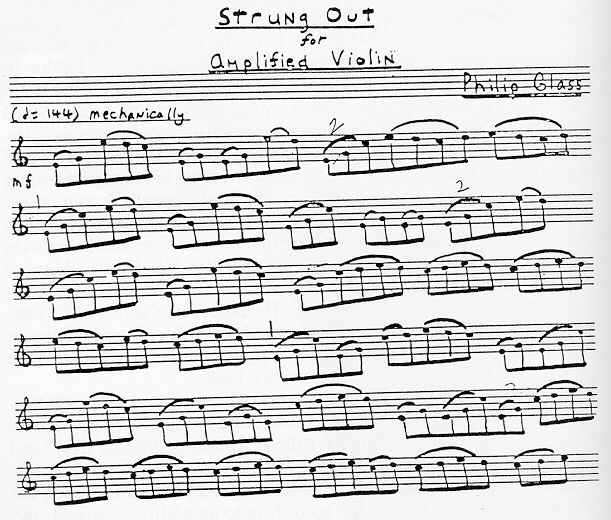

Like Music in Contrary Motion, the score for Strung Out is visually stimulating due to the symmetry of the notational progression. Strung Out is a more simple piece of music and, consequently, more easy to deconstruct. Both pieces are remarkable in that they are written in the key of C major (no sharps or flats) and contain no accidentals. Therefore, as is typical with minimalist music, the content closely resembles the form, which is why this piece is so visually demonstrative. As is common in Glass' music, he focuses his themes around simple and close intervals, and the challenge is to find within the seemingly simple framework where the pattern changes or progresses.
Strung Out is based on seconds and thirds (with a very occasional fourth), and the central interval is the tied EG that is repeated throughout the piece. This interval frequently serves as the pivot between symmetrical phrases. The first two stanzas of the composition read as follows: EGEDCEGEGDCEGCEDCDEDCDEGCEDEGEDCEGCEGEGEGCED. Within those stanzas, patterns such as the following occur (capitalization refers to groupings): "gEdcEG-EGdcEg." The hyphen in this pattern shows the point of symmetry around which the grouping "gEdcEG" is mirrored. Another pattern, "EDCD-EDCD," although not symmetrical in a mirrored form, does demonstrate a certain replication in pattern that reflects upon the symmetry of the overall form. Although we cannot offer a sound sample of this piece, one would expect that the sounds reflect the patterns, creating a similar effect for the listener as the score creates for the visual spectator. Given the simplicity of the piece, it is easy to play on the piano or violin, and any adventurous readers can discover the sound that matches the image.
Page author: Kirsten Lodal